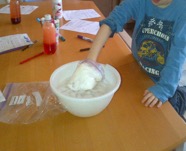Overview
Students will be able to understand one of the adaptations of living in cold environments.
Objectives
Describe what blubber is and how it works.
Lesson Preparation
- Partially fill a gallon-sized Ziploc bag with Crisco or shortening.
- Place another gallon-sized Ziploc bag inside.
- Merge the two bags together with duct tape.
Procedure
- Read the books Polar Bears by Laura Marsh and Polar Adaptations by Lisa Amstutz.
- Describe how the animals of the Arctic and Antarctic circles spend their lives surviving subfreezing air temperatures and frigid water. Their secret is blubber, a thick layer of body fat that comprises up to 50% of some marine mammals. Blubber is a common adaptation for polar mammals.
- Ask the students to describe what blubber is and how they think it helps animals survive where it’s really cold.
- Divide students into groups.
- Pass out the bowls with ice, the Ziploc bag of Crisco, and an empty Ziploc bag around the room to each group of students.
- Have each student voice their predictions of the difference between the Crisco-filled bag and using an un-insulated Ziploc bag.
- Test it out!

Students testing out the Blubber Glove. - Write down your results and have the students explain the differences between the two bags.
Resources
Books: Polar Bears by Laura Marsh and Polar Adaptations by Lisa Amstutz.
Author/Credits
Dieuwertje Kast (dj.kast.usc [at] gmail.com)
Standards Other
Next Generation Science Standards
3-LS4-2
Use evidence to construct an explanation for how the variations in characteristics among individuals of the same species may provide advantages in surviving, finding mates, and reproducing.
3-LS4-3
Construct an argument with evidence that in a particular habitat some organisms can survive well, some survive less well, and some cannot survive at all.
| Attachment | Size |
|---|---|
| Full Lesson: Polar Adaptations - Blubber (PDF - 264 KB)264 KB | 264 KB |
This program is supported by the National Science Foundation. Any opinions, findings, and conclusions or recommendations expressed by this program are those of the PIs and coordinating team, and do not necessarily reflect the views of the National Science Foundation.
